

Classic Buses Profiles
W.Alexander and Sons - 1930s Single Deckers (by Dick Gilbert)
Last updated 17 February 2023

SOME LINKS WITHIN THIS WEBSITE: Home Email Links THE COMPLETE WEBSITE MENU Events Diary Halfcab list Small-Ads Classic Irish Buses Classic Manx Buses
On this page we celebrate the huge fleet of 1930s front-engined single deck buses and coaches operated by W. Alexander and Sons throughout Scotland. This is not intended as a comprehensive fleet list, but came about as a result of the many fine pictures sent to me by George Bett, who was photographing buses in Scotland from the 1950s onwards, and has kindly made his collection available to me for display on the website. So this is really a photo scrapbook with expanded captions.
Acknowledgements: All photos on this page are by George Bett unless otherwise credited, and I am most grateful to him (and others) for allowing me to use them. Information has been gleaned from many sources, but special mention must be made of Allan T.Condie, whose thorough (and beautifully illustrated) book "The Bluebird Era" has been an invaluable reference. To obtain a copy of this, or his other works on Alexander double deckers and underfloor-engined single deckers, contact Allan T. Condie Publications, 6 St. Mary's Drive, Kinnoull, Perth PH2 7BY. Tel: 01738-446200. I recommend it.
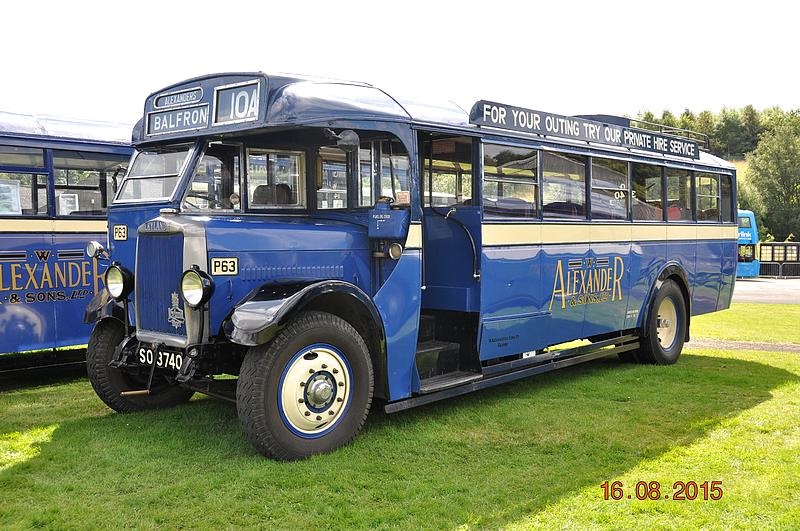
1929 Leyland Tiger TS2 No.P63 (SO 3740) which is privately owned and currently kept at the Scottish vintage bus museum, Lathalmond, where it was photographed by Ken Jones in August 2015.
Alexander's Motor Services of Kilsyth started operating in 1923, and W. Alexander and Sons Ltd. was formed in 1924. In 1929 the company joined the SMT group of companies, but retained its independence and, by this time, was operating throughout much of Scotland.
Simultaneously with this expansion, Alexanders had been building bus and coach bodies for their own use since their earliest operating days. From 1930 onwards this aspect of the business also expanded, and they began to produce bodywork for other members of the SMT group, and later for other companies as well. This enterprise was to become Walter Alexander and Co. (Coachbuilders) Ltd. in 1947, and is still active today.
The company's acquisition and expansion programme took a different turn in 1952, when all operations in the Inverness area were transferred to Highland Omnibuses. In 1961 the company, and its fleet of 2000 vehicles, was reorganised into three areas, Fife (based on Kirkcaldy), Northern (based at Aberdeen), and Midland (based at Falkirk). Each subsequently acquired its own livery, with Fife being red and cream, Northern yellow and cream, and Midland blue and cream.
Coaches from 1934 onwards were cream (or off-white) with variations of blue roofs and lining, and were given a "Bluebird" emblem, which became synonymous with Alexander's coaching activities, even after the adoption of the new regional liveries in 1961.
Vehicles were identified by a fleet number and a type prefix. The system varied over the years, but for the sake of the pictures shown here, A = Albion (pre war) and AEC Regal (post-war), BA = Albion (post-war), C = Commer, D = Daimler, F = Foden, G = Guy, K = Leyland Cheetahs, N and P = Leyland Lions and Tigers (becoming PA post-war), and W = Bedford.
Subsequent to the 1961 division into three areas, a further prefix was added to denote the district so, for example, PA100 would become NPA100, denoting a post war Leyland Tiger, fleet number 100, operating for the Northern division.
I hope you will enjoy this collection of pictures and, if you spot any mistakes, please let me know and I'll try and put them right.
1934 - LEYLAND LION LT5A
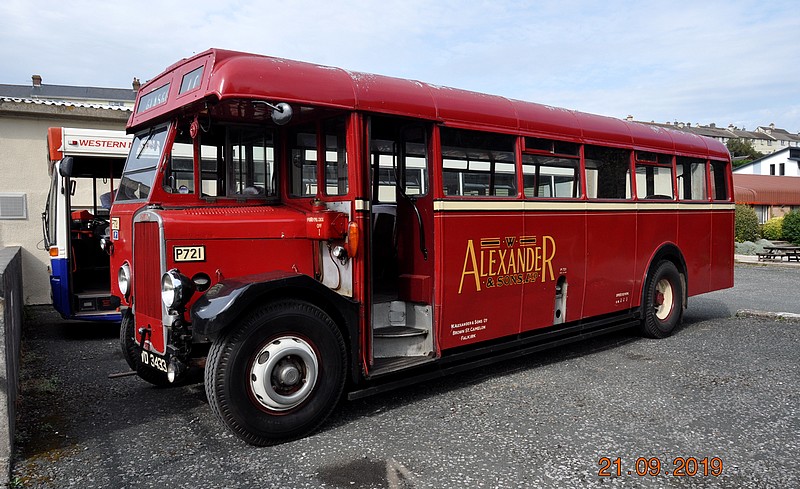
P721 (VD 3433) is a 1934 Leyland Lion LT5A. Twenty five Lions of this type dating from 1934-35, from the Alexander, SMT and Lanarkshire fleets, were rebuilt and rebodied by Alexander in 1945 and given a new lease of life to beef up the bus fleet in the immediate post-war years. They were numbered P687-688, P694, and P703-728 (with some numbers missing), with various FG, GS, VD and WG registrations. Several were painted red for Perth city operations, and P721 in the photo re-creates this perfectly as it had, indeed operated in Perth during its Alexander days.
By 1960, all had been withdrawn, but two survive, P721 (above), and P705 (WG 3260) owned by Jasper Pettie. Originally with Central SMT, P721 had subsequently passed from Alexanders to Lawsons of Kirkintilloch, before retiring from passenger service and becoming a showman's vehicle. Jasper and his team acquired it in 1973, restoring it to fine condition in its glorious red Perth livery in time for the 1976 London to Brighton run - a long way from home! It is now in the care of Quantock Heritage in Taunton, and Ken Jones took this photo when it was on static display at the Kingsbridge Running Day in September 2019.
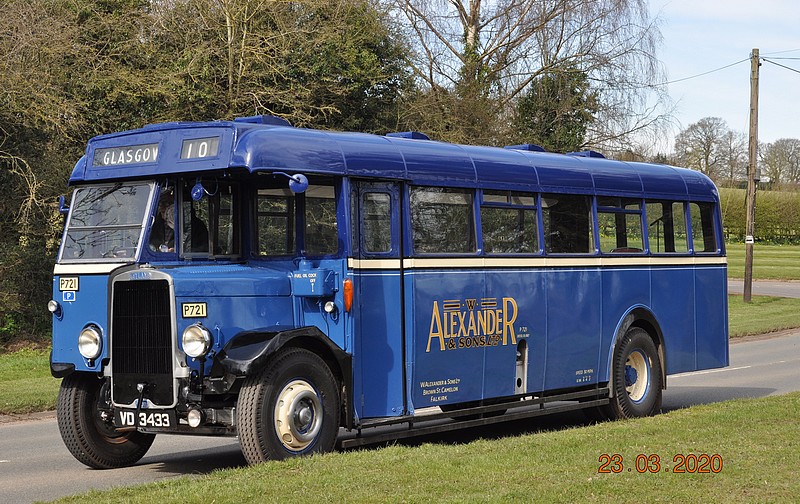
Early in 2020 the bus was repainted in two-tone blue livery with hand-painted signage. The picture above, again taken and kindly supplied by Ken Jones, shows P721 near Corley, Warwickshire when freshly emerged from the paint shop. It was soon to return to Somerset.
1937 - LEYLAND TIGER TS7 Coronation
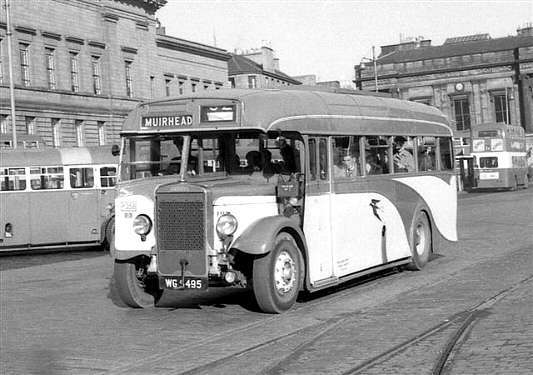
P358 (WG 5495) is seen in Dock Street, Dundee in the mid-1950s. Photo: George Bett.
When P358 was delivered in March 1937 it wore a special livery to celebrate the Coronation of King George VI. Although the normal scheme of off-white with a blue roof remained, the lining down the side and the front mudguards were painted red. Fifty Tiger TS7 coaches were delivered in February to April that year in this red, white and blue livery, and thus became known as Coronations. They were numbered P351-P410, with registrations WG 5487-5539 and 5919-5928.
Alexander had devised a new style of 35-seat all-metal body for these vehicles, in which the previous roof luggage racks had been replaced by a rear boot, enabling the use of a full-length opening roof for sunny days. This particular example lasted until 1961, but many survived until the end of 1963. Sadly none are still around today.
1937 - BEDFORD WTB
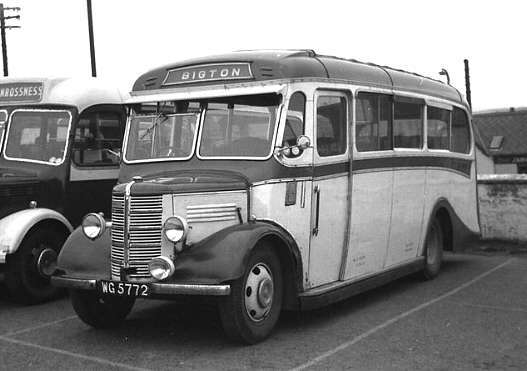
This ex-Alexander Bedford WTB was getting on a bit when photographed in the Shetlands in the early 1960s. Photo: George Bett.
Alexander had been acquiring deliveries of Bedford vehicles since 1931, and around 50 of the WTB models were purchased between 1936 and 1939. The 1937 delivery of 10 such vehicles were bodied by Duple, seating 20 passengers. They were numbered W52-W61 (WG 5328 and 5768-5776).
Withdrawal from service commenced in 1948 (including this example W57, WG 5772), but W53 remained in service with Alexanders for another decade. Clearly W57 is also still earning its keep more than twelve years after its retirement. As far as I can tell, no pre-war Alexander Bedfords survive today, but at least one wartime OWB model does.
1937 - LEYLAND TIGER TS7
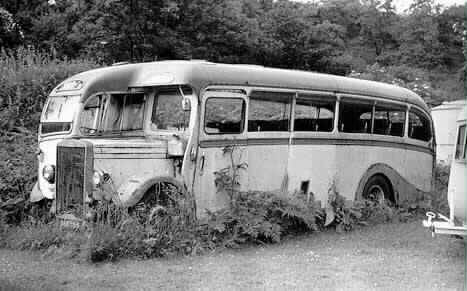
This Tiger TS7 (ASF 365) is looking very sorry for itself at Dufftown in the 1970s. Photo: Peter Findlay.
A bunch of 1937 Tiger TS7 buses were taken over by Alexander from SMT in Dundee at the end of 1949, and this was one of them. For those of a numerical disposition, there were seventeen in total, numbered by Alexander as P808-P815, P824-P829 and P837-P839. Their original SMT numbers had been respectively H153-159 (ASF 365-371), H183 (ASF 395), H160 (ASF 372), H165-166 (ASF 377-378), H169-170 (ASF 381-382), H172 (ASF 384) and H176-178 (ASF 388-390).
So P808 shown here was the first of these, all of which were originally delivered in June 1937. Although new with Alexander B35R bodies, four were rebodied by Duple as 33-seat coaches in 1951 and, again, P808 was the first for this treatment. As a result, these four vehicles outlasted the others in service by nearly ten years, and all went on for further work when withdrawn in the summer of 1964, including P808 which wound up with Patterson of Dufftown.
Despite its sad appearance in the picture above, P808 was to be gloriously revived as the only survivor of these ex-SMT vehicles:
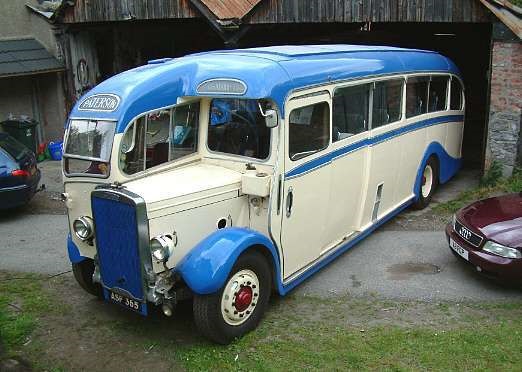
Peter Findlay kindly agreed to the use of this photo which shows ASF 365 when newly restored in July 2003 at its Dufftown home. He said "It travelled from Lathalmond to Dufftown last weekend via the Glamis Castle Rally, and won a trophy on its first rally appearance."
1938 - LEYLAND CHEETAH LZ2A
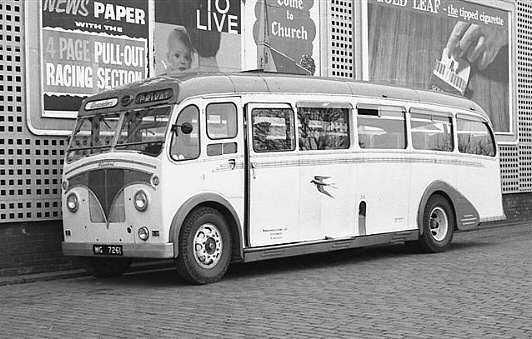
A much-disguised Leyland Cheetah No.K29 (WG 7261) is seen in Dundee in the late 1950s. Photo: George Bett
The Leyland Cheetah had been around for 3 years before Alexander acquired their first examples in 1938, and 30 of these were given C35F halfcab bodies by Burlingham (K6-K35, WG 7238-7267), the rest being bodied by Alexander themselves. Designed as a 'lightweight', the Cheetah lacked power for heavy duties, and it was only when larger engines were fitted to some of them post-war that the vehicles began to be more productive.
Some of this batch lasted only a year in service before withdrawal, and the rest were progressively sold off after the war, with the exception of nine which were given full-front body modifications in 1952. K29 was one of these, and they outlived their contemporaries to survive into the early 1960s. This example was retired in April 1963.
The Cheetah is a rare beast in preservation, with only half a dozen surviving. The Alexander machines are not amongst them.
1939 - LEYLAND CHEETAH LZ2A
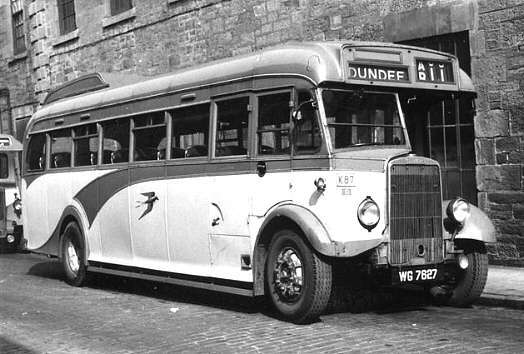
Another Cheetah in more original condition, K87 (WG 7627) is seen in Dundee in 1958. Photo: George Bett.
More Cheetahs arrived through 1938 and 1939, all to be bodied by Alexander. These C39F bodies proved to be very heavy for the Cheetah's Leyland "Light Six" engines, and they were all fitted with AEC 7.7 litre motors in the late 1940s. Nineteen were delivered in 1939 (the last to be acquired directly), and they were numbered K71-K89 (WG 7509-7517 and WG 7620- 7630).
So we are seeing here one of the last of the Alexander-bodied Cheetahs at the very end of its days, as Dundee-based K87 was retired in April 1959.
1939 - LEYLAND TIGER TS8
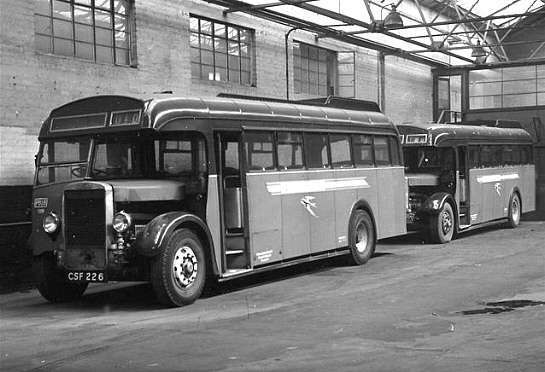
Tiger P818 (CSF 226) is among withdrawn vehicles at Seagate depot, Dundee in 1958. Photo: George Bett.
Like the 1937 Tiger TS7 P808 (ASF 365) shown above, the takeover by Alexander of SMT Dundee regional services in 1949 also meant the acquisition of some TS8 Tigers dating from 1939. There were 21 of these, numbered P816-818 (CSF 224- 26), P819 (CSF 231), P820-821 (CSF 233-34), P822 (CSF 244), P830-832 (CSF 236-38), P833-836 (CSF 240-43), P840 (CSF 232), P841-842 (CSF 245-46), P843-844 (CSF 250-251) and P845-846 (CSF 253-54).
When delivered to SMT in the spring of 1939, they had been allotted fleet numbers in the range H220- 243. After the transfer, some had their original Alexander bodies converted from rear to front entrance (B38R to B37F) in 1952, and P818 was one of those modified. Six were based at Dundee and they were all withdrawn by Alexander during 1956-58. This example (which had originally been SMT H225) was taken out of service in July 1958. Only one of these ex-SMT TS8s survives today, and it is this one! Ian McKerracher still owns CSF 226, albeit now converted to a recovery vehicle.
1939 - LEYLAND TIGER TS8
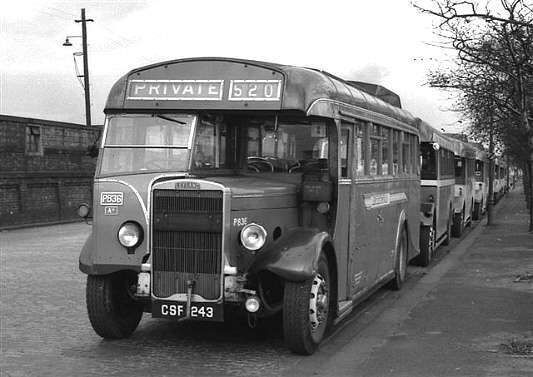
P836 (CSF 243) of Arbroath depot, seen at the Esplanade, Dundee in the mid 1950s. Photo: George Bett.
This was another of the ex-SMT vehicles acquired in 1949, from the same batch as P818 above, and it was withdrawn in February 1958. P836 (originally H232 with SMT) was another of the buses that had their entrances moved from the rear to the front in 1952.
The view you are seeing here on the Esplanade is described by George Bett. He says that, at least up to the mid 1950s, in late autumn a large number of Dundee schoolchildren went to pick potatoes, and an extensive fleet of buses were drafted in for the fortnight, hence the line of vehicles. He says "If I remember correctly we received 9 shillings and 9 pence per day for the privilege in 1951!"
1939 - LEYLAND TIGER TS8
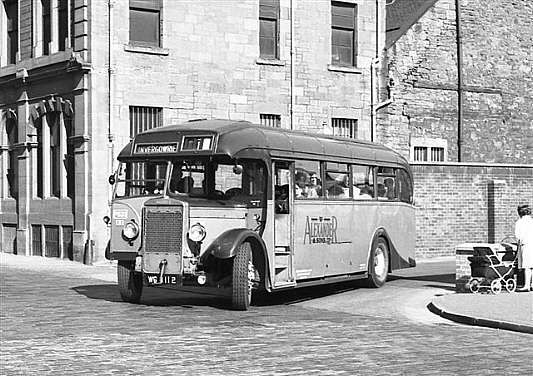
Alexander-bodied Leyland Tiger TS8 P533 (WG 8112) seen in Dundee around 1961. Photo: George Bett.
Fifty Tiger TS8 coaches arrived into the fleet between March and June 1939, and all were bodied by Alexander (C35F). They were P522 to P571 (WG 8101 to WG 8150). This was the first batch of vehicles to receive folding entrance doors from new. They all stayed in service until 1959-64, three of them then being converted into service lorries or recovery vehicles, including P528 (WG 8107) which is the only survivor of the fifty coaches today. It resides at the Scottish vintage bus museum.
P533 (WG 8112) seen here was delivered in June 1939, and was the last but one to be retired (October 1963), only P539 lasting longer (January 1964).
For more Alexander buses see 1940s single deckers and 1950s Single Deckers.
For many other buses, have a look at all the other profiles on the Classic Buses menu page.
SOME LINKS WITHIN THIS WEBSITE: Home Email Links THE COMPLETE WEBSITE MENU Events Diary Halfcab list Small-Ads Classic Irish Buses Classic Manx Buses